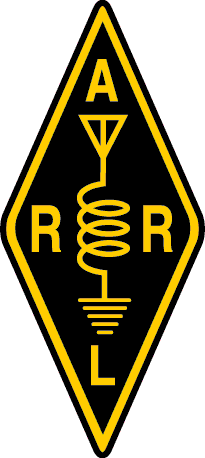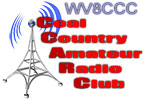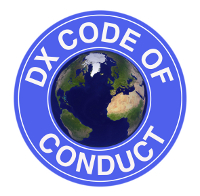Self-Study Guide
Introduction
The progression for HAM licensing goes from Technician (Element 2), to General (Element 3), and finally, Extra (Element 4). With each step, the material gets progressively more difficult. Consider the Technician Class to be of “entry level” material. In order to “Get on the Air”, you only need the Technician portion (Element 2) which will allow you limited access to certain bands/frequencies. As you progress through the elements, you gain more knowledge and thus, more access to other bands/frequencies. There is no more testing for “Novice” or “Advanced”, these have both been eliminated for new licensees and Morse Code is no longer required as part of any of the tests.
Studying to take your HAM exams may be accomplished via four different routes*. The best way, in my opinion, is to learn electronics, antenna principals, the rules and regulations and radio wave propagation. This is extremely time consuming to undertake as a whole. It is possible however to learn part of this and couple it with the other routes, which is to use www.hamexam.org Flash Cards and Practice Tests.
I cannot emphasize enough how well the “Flash Card” method at hamexam.org works. Of all the testing that I have done over the years, this is by far the easiest method that I have found to go over all of the questions/answers and concentrate on the sections you have the most trouble with. They have done it all on the backend of the website. You don’t need to keep track of ANYTHING. Once you get to the site, I suggest you go ahead and create a login. By creating a login, the site and the question pool will be tracked with your progress. If you have trouble in a particular area, the backend of the site will add weight to the questions in that portion and present those questions to you over and over (and more often). It is possible to utilize the flash cards and pass the technician test. A friend of mine went this route with no prior knowledge of radios and ACED the technician test. He admits that he doesn’t know what he’s doing, but he has his ticket and is willing to learn from Elmers.
* There is a fourth method, however this method isn’t for just anyone. It takes a special kind of student to be able to do the following: Practice Tests. There are a variety of different sites that offer practice examinations for the student to take. Practice Tests are a viable method of evaluating how your studying is working for you. You can either study, then take tests or you can simply take tests, memorizing the answers. However, this is difficult for many because there are 35 questions on the Technician and General tests and 50 questions on the Extra test. I don’t really care for memorization of material in order to pass a test, especially a test that you are voluntarily taking, in order to do something such as operate a HAM radio. Most folks that get into Amateur radio are doing so because they want a new hobby and to learn something new. Memorization, in my opinion, is not LEARNING. You can memorize stuff, but in the event you must think outside the box, how is the memorizing going to work for you? Chances are, it’s not. Therefore, I recommend studying, learning and applying this new knowledge toward your goal of bettering yourself and the HAM community by becoming an effective HAM operator.
Here is more information on the Question Pools, including a complete list of ALL QUESTIONS.
Band Allocation – Color PDF Poster of the U.S. Amateur Radio Ham Bands.
Fundamentals
Studying for the test (not knowing the material), memorizing test questions and answers is a method that many people use to get their Technician license and “get on the air”, which is fine, but there are certain things that you should learn in order to do the most basic tasks related to HAM radio operation.
- Study and learn Ohms Law. This is the most basic element in electronics as far as I am concerned. I’ve been working with low voltage electric components since I was 9 years or so. I learned about 12v systems and basic electronic theory at a very early age. Now, let me say this, you need to consider the word “theory” for a moment. In the scientific world, a “theory” isn’t a guess. A “theory” is pretty much LAW until proven otherwise…. so get that out of your head. Electronic Theory is accepted as being a law, until it is proven otherwise. Because we cannot really “see” something, we have to use the phrase “theory”. At any rate, learn Ohms law, inside and out. All it basically boils down to is simple algebra and transposition of numbers. In most cases, it’s extremely rudimentary and can be easily explained. Just don’t let yourself get overwhelmed. Many instructors will go about teaching Ohms law as it is something mystical and you will receive total enlightenment by the wonders of what they’re teaching. That’s not the case. Don’t expect the world to see you in a new light once you’ve learned certain things, you’ve just progressed one rung up the ladder of geekdom 🙂
- Learn the rules and regulations pertaining to HAM radio operation. There’s nothing more irritating than someone doing something wrong when it could be avoided.
- Learn to check your standing wave (SWR) and check it often. Radios, antennas and feed lines (antenna cabling) are susceptible to damage, bad alignment, disconnections, etc. and you can RUIN YOUR RADIO with bad standing waves (SWR).
- Be prepared to experiment. With experimentation comes failure. Don’t expect everything to turn out the way you planned it and don’t bank on your first attempt to be perfect. Plan, but understand that you may forget something. Maintain good practices, check and double check your SWR, but understand that you are human, you will make mistakes.
- Any type of radio, whether it’s HAM, CB or commercial (either industry specific, such as fire/police radio, ship-to-ship, ship-to-shore, radar, etc.) is a DYNAMIC endeavor. Do not allow yourself to be trapped into the line of thought that once you have it installed and working that is will remain in such condition indefinitely. This is a trap. Antenna feedline can change, antennas can deteriorate over time, radios have issues. There’s wear/tear on mobile components, such as wiring and front controls that will need maintenance. Be prepared to know what the symptoms of trouble are and how to get those problems resolved.
With the above being said, let me add, I am not going to reinvent the wheel here. I am going to utilize the resources we already have at our finger tips to help you achieve your goal of becoming a HAM radio operator. We will be using pre-written study guides from HAM Elmers. These are “Free to Use” guides, with all attribution going to the authors of these documents. I did not write these guides, I am merely pointing you in their direction.
Up until I took the amateur radio element 3 test (General) on the day I passed my Technician test (and did not study for General) I have only failed one test in my life, I went back and successfully completed the test the next day. That test dealt exclusively with Smith Charts, something you will see in Element 4 (Extra). Then, after successfully passing my element 3 (General), without studying I went ahead and took the Extra test and failed it as well. I dug in and studied the entire day of my second Extra test and successfully passed the test. I used the “flash card” method of studying at hamexam.org, went through all of the questions within 8 hours, drove 30 minutes to take the test where I was successful and passed the Extra and only missed 3 questions! (You know what they call a doctor that finished last in med school and last on his board test? Doctor 🙂
I went through electronics school at 19 years old, some 25 years ago and I’ve been working with electronics since I was very young. Elmers are HAM radio operators that’s been around the HAM community for a long time, paid their dues, know a lot of people in the HAM community, know electronics and spent hours on the radio. I only qualify with two of the above. I’ve spent hundreds of hours on the radio in various forms and I know electronics/antennas and RF propagation. While I can teach you how to study, what to study and the material, I cannot teach you about the community, how it’s changed, why not learning morse code is a bad thing or any of the subtleties of the HAM community. I am not sure whether my qualifications are good or bad. I know I am not going to teach you the “old” ways and I am not going to give you war stories about the “good ole days” of HAM radio…. but then again, I may not be passing on some of the bad attitudes I see from old hands either. We’re basically starting in this “new HAM community” together, I just happen to know the technical parts of it. I guess you could say that I am with you in building a more progressive, next-generation of HAM operators, for good or bad.
So, if I’ve been involved with electronics for this long and couldn’t pass my General or Extra without studying, what does that say about me? It says that the General and Extra encompasses different things than just electronics. The laws governing HAM radio are something unknown to the general public. Theory is theory, but if you don’t know the regulations, you can be the best technician in the world and still not pass the test(s). The same holds true for the engineering aspects of the Extra element. There are parts of the Extra test that I’ve never used in my experiences with electronics.
So, on with the study materials and less talk, we’ll save the talking for the airwaves 🙂 Here are a few links with brief descriptions of study guides and materials to get you started toward obtaining your HAM license. I will first share some of the “second route” material for “studying for the test”. This is a good way to get started. The latter section will be for basic electronic principles, rules and regs, antennas and radio wave propagation.
Methodology
Method 1: Flash Cards (at hamexam.org)
Go to hamexam.org and I suggest you create a login (it tracks your progress).
Choose the Flash Card link for the element you’re taking (ie. Tech, General or Extra).
Use the flash cards, go through ALL questions for the element you’re studying. When you’re finished with the flash cards, take a practice test. Do this over and over. Flash cards first, all the way through the entire question pool, then take a practice test. Rest. Take a test the next morning to see how much info you retained, go back and do the flash cards again. Take a practice test. Rinse, repeat until you’re confident in your ability to pass the test.
If you will notice while you are reviewing the flash cards, on the right, there’s an area on hamexam.org that calculates the on-going results of which questions you have seen. What happens on the back-end of the website, the questions you have seen are placed in a database, whether you answered the questions correctly or not is also noted and these questions and the elements in which they’re contained are “weighted” based on your answers and thus, the back-end of the website will throw these questions back at you, based on your correct or incorrect responses. While there may be 426, 461 or 711 questions in the class you’re studying, you may actually see 1100, 1500 or 1800 questions. These are repeated, based on the “weight” of your response and given to you over and over, allowing you memorize the answers more easily.
Method 2: Study for “The Test” – Radio Amateur HAM Technician Licensing Study Guide
*This method works for the Technician, General and Extra tests, just take out “Technician” below and enter “General” for the information given. Ther are study guides for all three elements available online.
When you are viewing “study for the test” material, you will notice elements listed as “T1A, T1B, T5A11, T7D01” and etc. These are test elements in numerical listing to let you know which part of the test the questions and answers come from. Each element of the test is comprised of a certain number of questions and answers. When the test is developed, random questions from each element are taken and added to the test. There will be a certain number of questions taken from each element. The test(s) are comprised of more questions from certain elements than other elements. You may take this into account when you create a test strategy. If you’re not a good test-taker, try to get with someone you know who is a good test taker and work out a study and test-taking strategy. You would be surprised about how you can formulate a plan to pass a test, even when you don’t know the answers to certain segments of a test.
First, I want to share the MOST IMPORTANT DOCUMENT I used to study for my technician exam. This Tech Study Guide helped me learn the questions that would be asked pertaining to the “rules and regs” of HAM radio use. This is the only part I was worried about when I took my Technician and General exams. I passed the Tech portion and I missed 5 questions. I passed the General portion and I missed 2 questions. I am not 100% sure, but I have a gut feeling that the questions I missed pertained more to the “rules and regs” rather than the electronic/wave propagation portions. I attribute my passing to cramming via these study guides as they pertain to the “rules and regs”.
1) The No-Nonsense,Technician Class License Study Guide – This guide is in my opinion, perfectly laid out for my style of studying. I printed out the guide, put it in a binder and used a highlighter to highlight the portions that I was either not familiar with or needed to brush up on.
2) Question Pools – I am no longer keeping up with the question pools and keeping copies available, a simple Google Search with the proper search string will render up to date question pools.
3) In addition to the above two items, it is also a good idea to take the practice tests as an assessment of how well you are studying the material. There are a variety of different websites that offer free HAM testing. Here’s a few different sites, which have different layouts but all utilize the standardized question/answer pool:
-
- QRZ.com HAM Tests (Make sure if you’re practicing for the TECHNICIAN portion, you use the “2014” version, not the 2010 version.
For the purpose of “test taking” here are some notes that I’ve found useful and may be applied to any study material that you are using to pass a test.
-
- Remember, you are trying to pass a test. You may not be interested in KNOWING the information right now, you can always learn that later, especially if you have some Elmers to hang out with. If you’re only trying to pass and know that you will learn the material later, forget trying to know the ins and outs of everything, just LEARN THE TEST.
-
- Try to associate the question with the answer by shortening the question and the answer, for example:
-
- Question T1A01 (C) [97.1]
Which of the following is a purpose of the Amateur Radio Service as stated in
the FCC rules and regulations?
A. Providing personal radio communications for as many citizens as possible
B. Providing communications for international non-profit organizations
C. Advancing skills in the technical and communication phases of the radio art
D. All of these choices are correct
- Question T1A01 (C) [97.1]
- Notice something to highlight in a questions, such as “purpose of Amateur Radio” and something to highlight in the answer (C), such as “art”; Therefore: “purpose of Amateur Radio = art”. ART is only contained in one of the four possible answers. By doing this, you dramatically decreased the amount of info you need to memorize.
-
- Try to associate the question with the answer by shortening the question and the answer, for example:
- For the person that is new to electronics, you may find yourself highlighting the entire guide. That’s ok because the guide is “No Non-Sense”. It is chock full of information that directly relates to the test and little else. Even after highlighting, if there were certain sections I felt needed to be emphasized, I added notes in the margin to go back and read on the DAY OF THE TEST. Mostly, these were formulas that I’ve known about for years but had trouble remembering.
-
- I would advise you to do two things: Place notes in the margins of things you are totally unfamiliar with and use these margin notes as your “Day of Testing” study guide. This will help you cram for the exam and keep the ideas fresh when you open the test booklet.
- And the second thing is to visualize Ohms law in a manner you can remember, whether it’s a graph or as simple as remembering E=I*R and data dump as much info as you can to the scratch paper the Volunteer Examiner gives you. I did this throughout Electronics school and it helped me tremendously. I started out with the basic Ohms law as above, E=I*R and slowly I progressed to adding more and more to the “data dump” on my scratch paper, such as E=I*R and P=I*E and so on to even including a formula for calculating capacitance (for some reason, I’ve always had a mental block for that). The term “data dump” means to take the bit of data you need for the test and write it down on the scratch paper the MOMENT THE SCRATCH PAPER IS GIVEN TO YOU. This helps alleviate mental blocks when the data is needed later on in the test. Without being able to data dump, there’s been many tests I probably would not have easily passed.
-
Method 3: Not just studying for the test, learning the material to become a better amateur radio enthusiast.
There are many different study guides, manuals, PDFs, etc. available for sale at many amateur radio sites and book sellers, such as Amazon. The “Gordon West” series have become the “go to” guides to learning about ham radio. The material contained within these publications will teach you, end to end, how to be a better ham radio operator and get you well on your way to becoming a good technician in the shack as well.
Method 4: Taking Practice Tests; Memorizing the Q&A
*This method works with General as well as Technician. With Extra, there’s more questions and thus, more questions on the test to memorize. It will of course work, based on your own capabilities. In other words, “end results will vary” 🙂 This method is similar to the “flash card” method of studying, however, it relies heavily on the tests presenting ALL of the questions/answers available in the pool. I don’t rely on this, I would rather see candidates using the “flash card” method, as it is known to present ALL questions/answers over time.
The principle is solid, if you are capable. Take the practice tests over and over until you’ve seen every question and answer and you have memorized the results. This is something for those with very good memories to do or those with basic electronics abilities (and/or have studied the material) and have a decent memory. I combined Practice Tests with Section 1 above as a means to a successful end. There are those among us however that are capable of memorizing 400+ questions and their answers. For those, here’s a repeated list of sites for HAM Practice Tests:
-
- QRZ.com HAM Tests (Make sure if you’re practicing for the TECHNICIAN portion, you use the “2014” version, not the 2010 version.




